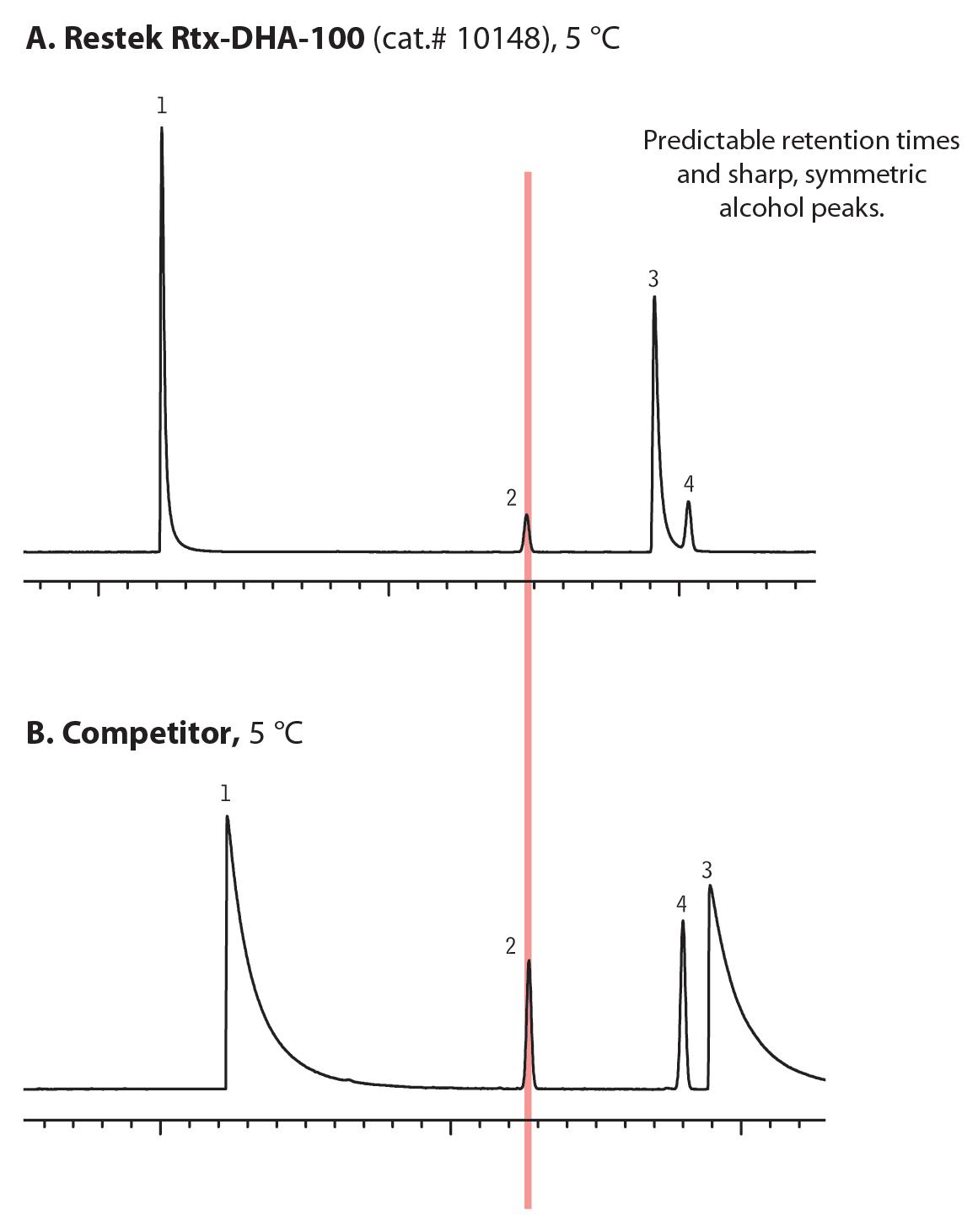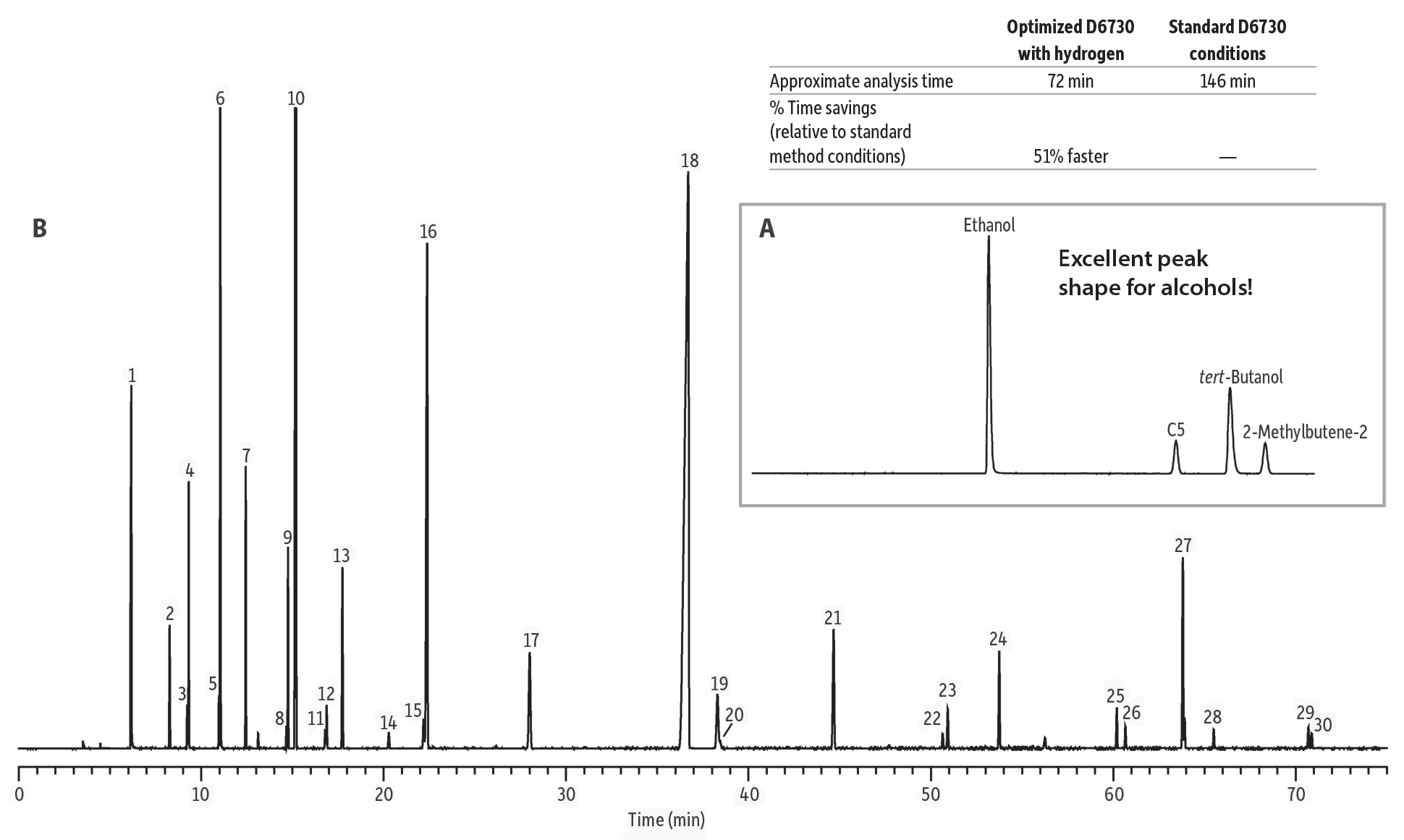Faster Detailed Hydrocarbon Analysis (DHA) Using Hydrogen
- Column meets or exceeds all ASTM D6730-01 (2016) and Canadian General Standards Board method requirements.
- More than 50% faster analysis (C13 retention time <71 minutes).
- Excellent response and peak symmetry for polar oxygenates.
- Guaranteed column-to-column reproducibility for retention, column efficiency, selectivity, peak symmetry, resolution, and bleed.
Accurate information about the concentrations of individual components in gasolines is critical for evaluating raw materials and controlling refinery processes. A high-resolution GC method for detailed hydrocarbon analysis (DHA) of gasolines is outlined in ASTM International (ASTM) Method D6730-01 (2016). ASTM D6730-01 (2016) is specific for the analysis of hydrocarbon components, plus oxygenated additives such as methanol, ethanol, tert-butanol, methyl tert-butyl ether (MTBE), and tert-amyl methyl ether (TAME) in spark-ignition engine fuels.
Historically, columns for DHA analysis have had several performance challenges, primarily centering on inertness and selectivity. Highly inert columns are required for the accurate analysis of polar compounds and inadequately deactivated columns result in poor peak symmetry and unpredictable retention times as demonstrated in Figure 1B. Similarly, developing columns with adequate selectivity for resolving key aromatics such as benzene, toluene, and p-xylene has also been difficult. Both of these issues have been overcome with Rtx-DHA columns, which allow accurate quantitative analysis and more precise control of blending (Figure 1A).
Figure 1: Rtx-DHA-100 columns are highly inert, resulting in sharp oxygenate peaks that elute at predictable retention times for more accurate detailed hydrocarbon analysis. (Oven temperature = 5 °C)

| Peaks | |
|---|---|
| 1. | Ethanol |
| 2. | Pentane (C5) |
| 3. | tert-Butanol |
| 4. | 2-Methylbutene-2 |
| Column | Comparison of competitor column and Rtx-DHA-100 column, 100 m, 0.25 mm ID, 0.50 µm (cat.# 10148) |
|---|---|
| Standard/Sample | Oxy setup blend, neat |
| Injection | |
| Inj. Vol.: | 0.1 µL split (split ratio 150:1) |
| Liner: | 4 mm ID deactivated cup inlet liner |
| Inj. Temp.: | 250 °C |
| Oven | |
| Oven Temp.: | 5 °C |
| Carrier Gas | H2, constant flow |
| Flow Rate: | 3.62 mL/min |
| Linear Velocity: | 55 cm/sec |
| Detector | FID @ 300 °C |
|---|---|
| Notes | The chromatograms are aligned on pentane (C5). Note that the analytical column was originally named Rtx-1 PONA cat.# 10195; it has since been renamed (no other changes) Rtx-DHA-100 (cat.# 10148). GC inlet liner cat.# 20709 was used to produce this chromatogram. It has been replaced by Cup Splitter Inlet Liner (cat.# 20710). |
Restek worked in a long-term collaboration with the late Neil Johansen (who passed away September 20, 2011 and was one of the original DHA method developers) to engineer a selective and highly inert DHA column that meets or exceeds all ASTM D6730-01 (2016) and Canadian General Standards Board (CGSB) requirements. Originally, this column was sold as the Rtx-1 PONA column, but it has been renamed as the Rtx-DHA column line, for better alignment with method nomenclature. No changes were made to manufacturing, so the columns and chromatographic performance are exactly the same. In addition to meeting or exceeding all method parameters, Rtx-DHA columns are exceptionally robust. They can be used with either helium or with hydrogen carrier gas under an accelerated temperature program, providing an effective option for significantly increasing sample throughput without compromising chromatographic performance.
51% Faster Run Times with Hydrogen
While D6730-01 (2016) specifies helium as the carrier gas, hydrogen is a better alternative because it can be used at higher linear velocities without compromising critical separations. For detailed hydrocarbon analysis, using hydrogen as the carrier gas offers some distinct advantages over helium: (1) it can be used at twice the linear velocity, and (2) it is less expensive and more readily available. Despite these advantages, some labs have reservations regarding the safety of using hydrogen. In fact, with basic precautions, hydrogen can be used safely and reliably, particularly when hydrogen generators are used instead of freestanding cylinders (1,2). As shown in the chromatogram in Figure 2, which was generated by Neil Johansen using hydrogen carrier gas, all critical components are resolved in a greatly reduced run time of 71 minutes versus a typical run time of 146 minutes. This analysis time savings of more than 50% has the potential to virtually double sample throughput.
Figure 2: Increase sample throughput and cut analysis times in half without compromising resolution by using hydrogen instead of helium.

| Peaks | |
|---|---|
| 16. | Toluene |
| 17. | Octane (C8) |
| 18. | Ethylbenzene |
| 19. | p-Xylene |
| 20. | 2,3-Dimethylheptane |
| 21. | Nonane (C9) |
| 22. | 5-Methylnonane |
| 23. | 1,2-Methylethylbenzene |
| 24. | Decane (C10) |
| 25. | Undecane (C11) |
| 26. | 1,2,3,5-Tetramethylbenzene |
| 27. | Naphthalene |
| 28. | n-Dodecane (C12) |
| 29. | 1-Methylnaphthalene |
| 30. | Tridecane (C13) |
| Column | Rtx-DHA-100, 100 m, 0.25 mm ID, 0.50 µm (cat.# 10148) |
|---|---|
| using Rtx-5 DHA tuning column* 2-5 m, 0.25 mm ID, | |
| Standard/Sample | DHA/oxygenates setup blend |
| Injection | |
| Inj. Vol.: | 0.1 µL split (split ratio 150:1) |
| Liner: | 4 mm ID deactivated cup inlet liner |
| Inj. Temp.: | 250 °C |
| Carrier Gas | H2, constant flow |
| Flow Rate: | 3.62 mL/min |
| Linear Velocity: | 55 cm/sec |
| Detector | FID @ 300 °C |
|---|---|
| Notes | GC inlet liner cat.# 20835 was used to produce this chromatogram. It has been replaced by Cup Splitter Inlet Liner (cat.# 20836). *Note that the exact length of the tuning column was determined experimentally based on the resolution of critical pairs as per method D6730-01 (reapproved 2011). Oven Temp. A: 35 °C B: 5 °C (hold 8.32 min) (elute C5) to 48 °C at 22 °C/min (hold 26.32 min) (elute ethylbenzene) to 141 °C at 3.20 °C/min (elute C12) to 300 °C at 1 °C/min A: Front end of DHA/oxygenates setup blend C5 Efficiency: 586,825 plates C5 k': 0.476 tert-Butanol skew: 2.10 Resolution: tert-Butanol/2-methylbutene-2: 5.39 |
| Acknowledgement | Chromatogram courtesy of Neil Johansen, Inc., Aztec, New Mexico, in association with Envantage Analytical Software, Inc., Cleveland, Ohio. |
Conclusion
Restek Rtx-DHA-100 columns are individually tested and stringently controlled for retention, efficiency, peak symmetry, selectivity, resolution, and bleed. These columns meet or exceed all ASTM D6730-01 (2016) and CGSB method requirements and display excellent peak symmetry for polar oxygenates and reliable separation of all critical pairs. This allows users to obtain more correct and consistent detailed hydrocarbon analysis data, especially for oxygenate content. As shown here, the robustness of these columns even allows them to be used with hydrogen under accelerated temperature conditions, resulting in more than 50% faster analysis times. These performance gains allow refinery labs to process samples faster and make more profitable decisions during product blending.
References
- J.V. Hinshaw, Frequently asked questions about hydrogen carrier gas, LC-GC November (2008) 1100. http://www.chromatographyonline.com/frequently-asked-questions-about-hydrogen-carrier-gas
- P. Froehlich, Using hydrogen for gas chromatography, Lab Mgr, 2 (2007) 17. http://photos.labmanager.com/magazinePDFs/archives/labmanager200702-dl.pdf

